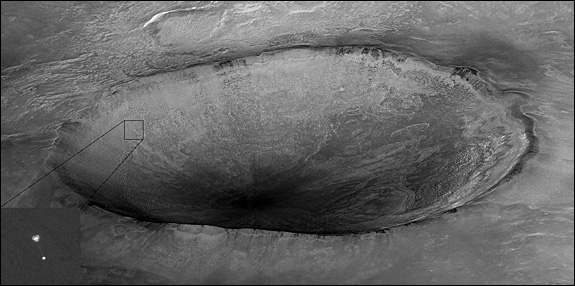Mars probe expected to find water, possibly signatures of life
Past, present, and possible future life on Mars may depend on water that’s most likely locked near the planet’s north pole. For the first time in human history, NASA’s Phoenix Lander will reach out and, scientists expect, touch extraterrestrial water – analyzing it for critical amino acids and other signs of life.
Late Sunday evening, Phoenix relayed news of its harrowed, but successful landing, each phase of which relied on unfailing precision. Within two hours of touchdown, the lander transmitted its first pictures from the northern region of Mars, revealing a barren flat landscape pockmarked by eerily regular patterns of polygons. These natural geometric forms are the first telltale signs of frozen water lying just a tantalizing few inches below the lander, NASA researchers say.
The probe is NASA’s first successful polar landing on the Mars after a string of failures. “Only five of our planet’s 11 previous attempts to land on the red planet have succeeded,” said Ed Weiler, NASA associate administrator for science missions, in a press release. “In exploring the universe, we accept some risk in exchange for the potential of great scientific rewards.”
With its solar panels fully expanded and other equipment engaged, the lander prepared to extend its eight-foot robotic arm sometime late Wednesday. While the initial test of the arm was scheduled for Tuesday, a minor communications error forced NASA to delay the deployment. The arm will be used to dig samples of dirt and icy for testing.
The lander’s onboard scientific equipment, developed with technological prowess from eight countries, will test for evidence of microbial life and explore the history of water on Mars.
Previous missions, including most significantly the orbiter Mars Odyssey, identified the best locations for the Phoenix mission site by detecting traces of subsurface water. Odyssey and the Mars Reconnaissance Orbiter (MRO) will act as relay antennas for data streaming from Phoenix.
William K. Reilly, former EPA Administrator, compared the ironies of water stewardship on Earth and the search for extraterrestrial water on Mars during his presentation, “Water for a Sustainable Future” at the 2004 National Conference on Science, Policy and the Environment: “Why are we going to Mars, and what are we looking for? We’re looking for water… because if it’s there, there could be life.”
Resources:
University of Phoenix: Mission Page
NASA Spacecraft Ready to Dig on Mars – NYTimes
Mars lander gets orders to extend arm – CNN.com
National Council on Science and the Environment
Water for a Sustainable Future
Circle of Blue’s east coast correspondent based in New York. He specializes on water conflict and the water-food-energy nexus. He previously worked as a political risk analyst covering equatorial Africa’s energy sector, and sustainable development in sub-Saharan Africa. Contact: Cody.Pope@circleofblue.org









Leave a Reply
Want to join the discussion?Feel free to contribute!